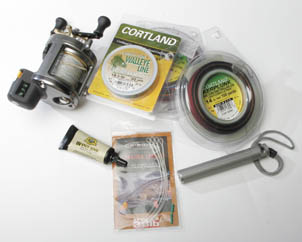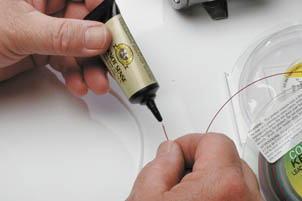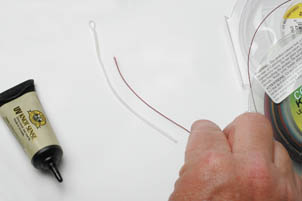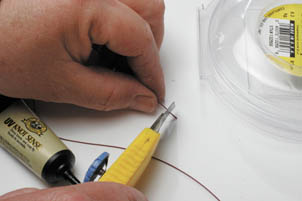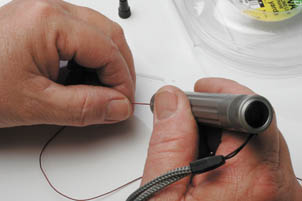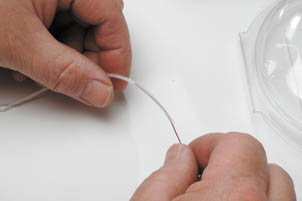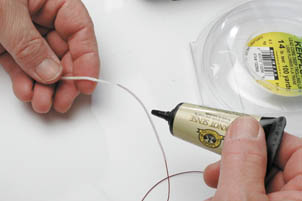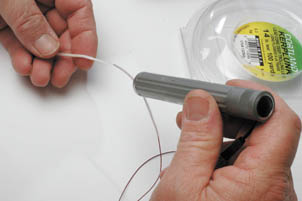Leadline trolling - An effective and essential technique for Tasmania
Trolling guru, Bill Presslor takes a close look one of his favourite trolling methods - leadline
Most freshwater trollers have at one time or another had at least some experience with lead core lines. Whether you love it or hate it, lead core catches fish!
Basically, lead core line, a lead wire covered by woven nylon, has been around for over fifty years and was developed as a means of trolling lures deeper than they could be trolled by traditional means. Used in conjunction with downriggers, planer boards and surface or flat lines, lead core lines can add versatility to any trolling spread. They are often the most productive option when you need to get your lures that little bit deeper. In lakes such as Arthurs Lake, Great Lake and Dee Lagoon lead core lines are bound to improve your catch rate.
Advantages of lead core
No matter what you feel about lead core it catches a lot of fish. Lead core achieves depth without making any noise in the water to warn fish of any impending danger. As well, lead core will usually involve long lengths (both leader and lead core) of line in the water which means your trolled lure or bait is a long way from the boat making it much less likely to spook the fish.
Recent research in the USA has shown that there is a lot more to lead core than simply getting a lure deeper. Most fishing lines (braid and monofilament) float or at least have some buoyancy in the water. Line buoyancy and water resistance as lures are trolled creates a bow or curve in the fishing line. Most anglers have no idea that this phenomenon occurs. Lead core flows through the water differently than monofilament or super braid lines and because of this there seems to be a wealth of myths and misinformation that surround the use of lead core lines. Over the years I've had many trollers try to tell me that lead core is only useful down to about five colours out due to the line forming a belly beyond this depth. The laws of physics easily prove that this is not possible and I suspect that what started this fallacy was someone snagging the line after a sharp turn or sudden change of speed. Lead core lines sink at a controlled rate, the line tends to run in a descending straight line from the rod tip to the lure. Due to this phenomenon no significant bow or curve forms in the line while trolling. With little or no bow in the line, as soon as a fish hits a lure fished on lead core it feels resistance and the hook is set. This is the main reason why lead core hooks more of the fish that bite.
A word of caution for the uninitiated! As anglers we have all probably had the old pump and wind technique drummed into us since childhood. If you use this method with lead core lines you will lose a lot of fish. The weight of trolled lead core lines, as well as the water resistance, will almost certainly guarantee that even the smallest amount of slack created when you €œwind down€ will cost you a fish. A better approach I believe is to keep the rod tip up and wind smoothly, allowing the drag to work if the fish goes for a run. Even very big fish will struggle to pull a long length of lead core through the water for very long.
Segmented lead core
One major difference between how lead core is used in the USA compared to how we use it here is segmentation. Instead of using lead core as a continuous sinking rig like we do in Australia, most charter captains on the Great Lakes in the USA run segments of lead core sandwiched between a monofilament leader and mono or super braid backing. On large charter boats many captains will have up to a dozen different reels loaded with varying amounts of lead core. This allows them to fish several lines at different depths. For most of us this is not really practical, however segmentation is still worth pursuing under our fishing conditions.
Lead core line is not a durable line that can stand a lot of abrasion or flexing. When the line is bent, as in coming out of the rod tip, the lead wire inside the nylon can break. This will eventually wear away the nylon sheath from the inside. To avoid line failure it is better to fish lead core in segments suitable to reach the targeted depth range you're after. Doing this allows you to put the entire lead core in the water and have the backing coming out of the rod tip. Obviously the more segments that are fished the deeper the line will run. Although many charter captains in the USA run up to as much as 20 colours (Each colour is 10yards of line) of lead core for trout and salmon, most walleye anglers use 2-3 colours very effectively. Our conditions would suggest that about 3-5 colours is very effective for our trout and salmon. I always have at least one reel in my box loaded with 10 colours of lead core and I use it a lot! This technique will also work for many of our native species, though I would suggest that few anglers have bothered to try it.
Spools of lead core are available in lengths of 3 colours (30 yards), 10 colours (100 yards) or 20 colours (200 yards) in a range of breaking strains. Keep in mind that the breaking strength of lead core is not necessarily a good indication of its ability to sink. Breaking strains for lead core are determined by the strength of the nylon sheath not the lead wire. The same limitations that apply to monofilaments in regard to their ability to reach a particular depth also apply to lead core. Heavier breaking strains such as 27lb or to a lesser extent 18lb have a larger diameter and create more water resistance when trolled. For our fishing conditions here in Australia, I prefer to use lead core line of 14lb breaking strain (made by Cortland) for both trout and natives. The biggest advantage with using lighter line is the added depth. 14lb lead core will troll approx 15% deeper than 18lb at the same speed. Lead core line is highly speed dependant, the faster you troll the less depth you will be able to achieve.
For many years I used mono or Dacron as a backing, but I now prefer to use braid. The small diameter for breaking stain of the super braids allows me to increase the amount of lead core I can get on to my reels.
Leaders and the critical connection.
The connection between lead core line and a mono leader is critical to your success with this material. Standard practise for most trollers has been to tie a nail knot to join leader and main line. Some trollers even remove a small section of lead from the line and tie a knot to join leader and main line. I find this method fairly cumbersome and time consuming. To attach my leader and backing to the lead core I use braided fly-line loops made by Vision. These braided loops allow me to use a loop-to-loop connection (or any other dependable knot) for attaching my backing to the lead core and changing or replacing a leader (see photo sequence). Leader lengths can vary according to conditions from 1-15 metres, though a leader length of about 2m is what I use in most of our impoundments. For leaders I now use fluro-carbon almost exclusively.
Conclusion
To my way of thinking lead core lines are essential and very effective tools for trolling. This technique can allow you to run multiple lines in areas that are loaded with snags without the fear of losing expensive downrigger gear. Whether you swear by them or at them, lead core can give you another option to add to your trolling arsenal.
Reels for lead core lines
One of the few drawbacks with running lead core is that you need to run heavier tackle than for normal flat-line trolling under our conditions. Most overhead reels that we use for trout and salmon aren't big enough to hold a significant amount of backing and lead core line. If you choose to run large amounts of lead core you will need a substantial reel. The ideal reels for lead core fishing are those that have a large line capacity and a medium to fast retrieve ratio. If you have 7 or 8 colours of lead core out behind the boat slow retrieve reels can take forever to wind in long leads of lead core. Depending on your application good reels include:
Abu 6500c (up to 5 colours)
Okuma CV45D (up to 10 colours)
Shimano Charter Special 2000 series (7-8 colours)
Shimano Tekota Series (5-20 colours depending on the model)
Penn International 975LD (7-8 colours)
Penn 330GTI (up to 10 colours)
Tips for success
- Lead core is very speed sensitive, slower trolling speeds (.5-2kph) will achieve greater depth. Faster trolling speeds will dramatically affect the depth you can reach.
- Lead core lines with a breaking strain of 14 -18lb breaking strain are just about right for our fishing conditions. As with all types of trolled lines, smaller diameters will help achieve greater depth.
- If you want to run two lead core lines on the same side of the boat, run the longer length on the inside and the shorter length on an in line board farther out from the boat, outside of the longer line. When a fish hits, the shorter line will swing back behind the boat above the deeper inside line, avoiding tangles.
- Think carefully about running extremely long lengths of lead core. The risk of tangling lines with other boats in the area becomes much greater when you have long lengths of line out.
Photo sequence
The photos show the steps to complete the connection using Cortland 14lb. lead core, Vision 30lb. braided loops, Loon Knot Sense and Loon UV Torch. There may be other brands that work with this technique, but I know this works and has great strength. Once you have tried this you'll find it very quick to do, even on the water.
Bill Presslor
